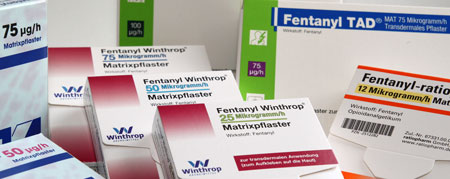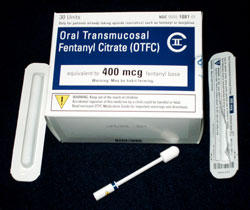
Source: Wikimedia by Alcibiades.
Fentanyl is within the category of drugs called opioid analgesics. Analgesics are a drug class that help relieve the body from the sensation of pain by blocking chemicals in the brain neurons that sense pain. Neurons send messages from the body to the brain; different types of neurons sense different things (eg, temperature, pressure, pH).
Nociceptors, nerve receptors for pain, send messages from noxious stimuli to the brain from the skin, organs, and muscles that something is potentially hurting the body. Nociceptors send messages about pressure, sharp objects, noxious smells, tastes, and pain and the brain interprets those for immediate response to protect the body.
Several neurotransmitters send pain signals, but the main ones are glutamine and substance P. When noxious stimuli trigger the primary neuron through the skin or muscle, for example, the message is relayed by a secondary neuron to the spinal cord’s dorsal root ganglion and on to the brain for interpretation.
The neurotransmitter chemicals are relayed to the thalamus in the brain and then onto the limbic system for an emotional response. Ideally the message to the limbic area of the brain promotes learning to avoid the cause of the noxious substance in the future. Opioids inhibit pain signals at multiple areas in this pathway. Opioids affect the brain, the spinal cord, and even the peripheral nervous system.
Opioids work on both directions in the nervous system, including (1) the ascending pathways in the spinal cord, which are inhibited; and (2) the descending pathways, which block inflammatory responses to noxious stimuli. In the brain, opioids cause sedation and decrease the emotional response to pain. Heroin, like morphine, passes through the liver and then is released back into the blood, where it passes the blood-brain barriers. Heroin is then converted to morphine where it connects with mu receptors and heroin is 3 times more potent than morphine.
Did You Know . . .
Morphine is the standard to which all opioids are compared.
The three major opiate receptors are mu, delta, and kappa, all of which act on the dorsal horn of the spinal cord and cerebral cortex. Although morphine and opiates block the pain sensory pathways to the cerebral cortex and limbic system, they also act on respiration, mood, and emotion. Opioid receptors are found on both the primary and secondary neurons, and when opium-like drugs bind to these receptors, no other pain signals are sent to the brain, making opioids very effective against pain.
Endogenous analgesic receptors include human endorphins. Our bodies’ three receptors can be activated by opioid agonists like morphine, hydrocodone, or heroin. When mu receptors are activated, dopamine, a natural chemical associated with pleasure, is also increased. Pleasurable feelings are inherently worth repeating, which drives the user to repeat the drug use.
Morphine and opioids are easily absorbed by the gastrointestinal tract, nasal mucosa, and lungs. When fentanyl crosses the cellular membranes into the brain, altered cognition makes it difficult to recognize rising carbon dioxide levels in the lungs, which can lead to respiratory acidosis or even complete respiratory cessation. For drugs to work, they must pass the high lipid blood–brain barrier. Fentanyl is fat soluble, which means it can pass into brain tissues extremely fast—more rapidly than morphine.
Novel synthetic opioids (NSOs) are the next generation of opioid drugs and are more potent. A lethal dose of fentanyl can look like two grains of salt (approximately 2 mg), making it difficult to dose correctly. In 2015 the Drug Enforcement Agency (DEA) and CDC issued nationwide alerts that fentanyl is a threat to public safety (Peterson et al., 2016). The NSOs do have a place in clinical usage due to their high potency, low cardiovascular effect, rapid onset, and short duration of action (Vucković et al., 2009).
Additional variations and analogs are being produced both legally and illegally with even stronger potency, such as carfentanil (also spelled carfentanyl), which is 100 times as potent as the same amount of fentanyl and 10,000 times stronger than regular morphine (Boston Globe, 2018). Carfentanil is being explored for chemical warfare and has been used as an elephant tranquilizer because of its potency. It is now creating human deaths due to its powerful effect (Baumann, 2018).
Because of the potency of fentanyl, the withdrawal symptoms are equally as strong, lasting up to a week, making cessation of the habit difficult for users and abusers. Carfentanil was not a controlled substance in China until 2017, although it was first synthesized in 1974. It is a classified Schedule II drug in the United States (Shoff et al., 2017).
Short-term sensations of opioids include the following:
- Warmth sensation through skin and body
- A feeling of heaviness in arms and legs
- Pain relief
- Euphoria
- Itchiness
- Possible dry mouth
- Drowsiness
- Slowed heart functioning
- Slowed breathing
- Relaxation
- Sense of well being
Opioid agonists come with additional noxious side effects. When a kappa receptor is stimulated it can also produce hallucinations, anxiety, and restlessness. Delta and mu receptors can cause respiratory depression because, as the midbrain is stimulated, it suppresses the body’s ability to detect carbon dioxide levels, which is the main stimulus for breathing. Other negative side effects include constipation, sedation, nausea, dizziness, urinary retention, and tolerance. Tolerance is the requirement of the body for increased amounts of the drug to reach its desired effects, which is why opioids can become addictive; the person continues taking more and more of the drug to achieve the desired pain relieving and sedating effects (Dunphy, 2016).
The key ingredient in opium is morphine, which began to be produced formally by the pharmaceutical company Merck. It was discovered that when administered by IV, morphine is 3 times more potent than when administered by other methods such as smoking or snorting.
Long-term use of opioids has been shown to cause the deterioration of the brain’s white matter and includes effects of insomnia, chronic constipation, sexual dysfunction, irregular menstrual cycles in women, kidney disease, and physical damage resulting from administration by snorting, smoking, or IV drug use.
Although cocaine and morphine both affect the neurotransmitter dopamine, they work in different ways. Whereas the opioids increase dopamine stimulation, cocaine blocks the reuptake of existing dopamine and makes it last longer, producing a longer state of pleasure. Both opioids and cocaine drugs do influence the brain’s interpretation of the pleasure drive, reinforcing the urge for repeated behavior to get the drug.
In addition to the short-term withdrawal symptoms, long-term opioid use causes:
- Decreased ability in decision making
- Decreased ability for self-reflection and discipline
- Decreased ability to effectively respond to stress
Route and Administration of Fentanyl
Transdermal Patch

Source: Wikimedia by Daniel Tahar. Transdermal fentanyl.
Opioids can be administered by FDA approval through the subcutaneous, intramuscular, intravenous, and oral routes but due to variations in first-pass liver metabolism there are variations of response by users. Non-prescription drug users often speed the delivery by nasal and intravenous administration. The potency of fentanyl and carfentanil have been demonstrated by the rapid deleterious effects on police officers who have come in contact with the powder through their skin during drug investigations and raids. One police officer overdosed just by brushing power off of his uniform with his hand (Moshtaghian, 2016). Subcutaneous fentanyl is commonly used to address chronic local pain; there is a transdermal fentanyl patch that has a slow release action. When fentanyl is delivered through more rapid routes such as IV or intranasal, the response is much quicker and therefore potentially fatal. Street products include variations of many of these routes of administration but also include lozenges laced with fentanyl.
Appropriate Use of Fentanyl
Fentanyl Lollipops

Source: Wikimedia by Crohnie.
As a potent opioid narcotic, fentanyl is a powerful analgesic to treat chronic pain. It is not intended or appropriate for occasional, short-term, or light pain. Fentanyl is usually administered by injection or topical patch in the hospital setting. It may be prescribed through the intradermal route for chronic pain and is classically used for chronic lower back pain. Brand names also offer fentanyl in other routes, including:
- Abstral (sublingual)
- Actiq (lozenge or “lollipop”)
- Duragesic (transdermal patch)
- Fentora (buccal tablet)
- lonsys (transdermal device)
- Lazanda (nasal spray)
- Subsys (sublingual spray)
Dosage varies based on the route and is in Mcg, not mg, and can be seen at this URL:
https://www.drugs.com/dosage/fentanyl.html#Dose_Adjustments
Clearly there are appropriate roles for this medication as a treatment for millions of people suffering from chronic pain. In the hospital setting it is often used post operatively. Because it is a narcotic, it is important that it be monitored closely for respiratory suppression and adverse reactions. Of course, it should not be used by someone who is allergic to the drug, has any type of breathing problem, a history of head or brain injury, liver or kidney disease, slow heart rhythms, concomitant use of sedatives like Valium, or if a MAO inhibitor has been used in the past 14 days or the client is already taking another narcotic. There are no adequate studies to confirm safety or danger in pregnancy or breastfeeding so providers must be notified and careful clinical be consideration given to weigh benefits from any possible damage to infants and mothers because it is a Category C and risk cannot be ruled out (Drugs.com, 2018).
Patient Education and Support
Online and face-to-face support groups are available to help with effective and appropriate use of fentanyl. Often the only information provided is about the serious opioid epidemic and potential risk for addiction and abuse; however, when used properly and within the clear instructions given by a medical provider who is monitoring for adverse reactions, it can be a helpful option for people in very real chronic pain.
Using all medications as directed is important because the route has been chosen for specific reason. Unfortunately, a dangerous practice of chewing on a transdermal patch can speed up the delivery of the drug and create addiction and possibly respiratory depression and even death. Mental and physical dependence can still occur even at prescribed doses so patients must be carefully monitored.
Supporting patients in their quest for relief from pain and judgment is extremely helpful. In the national conversation about opioid abuse, patients who have very real chronic pain continue to suffer as physicians are attempting to prescribe less and pharmacies are blocking repetitive refilling of narcotics. The dialog for effective pain management and effective systems to prevent opioid abuse must continue in creative, nonjudgmental, and respectful ways. Clinicians should support groups who can speak freely about issues and concerns. Not all people who use fentanyl are drug addicts and they should not be treated as such.
The onset of pain-blocking effects of intradermal fentanyl takes from 12 to 48 hours, and even up to 72 hours, and may require a breakthrough alternative until the full effect is achieved. Titrating carefully for pain relief is required based on individualized patient needs. Variations in the need for higher dosages depends on the location of a transdermal patch, the quantity of fat on the body area and the dryness of the skin it is applied to.
Did You Know . . .
All patients should be taught to avoid alcohol consumption if using fentanyl.
Patients also need to be aware that the narcotic may remain in the bloodstream for up to 3 days and can be residual in hair and urine. Drug testing for abuse or employer use is mostly commonly done this way.
Patient education should include instructions on careful timing and use of the drug, adverse reactions and side effects, and drug interactions and contraindications. When a patient follows instructions given by a provider, overdosing is generally not expected due to careful guidelines and timing instructions. Other drugs however, may interact with fentanyl and change the effectiveness, onset, peak, duration, and half-life of the drug. Drugs such as other narcotics, including even cough medicine, sedatives, tranquilizers, antipsychotic medicine, and drugs that affect breathing and serotonin levels may all negatively interact with fentanyl.
According to drugs.com, 945 drugs have known interactions with fentanyl including 4977 brand and generic names. A database of medications that may interact with fentanyl is available at this URL:
https://www.drugs.com/drug-interactions/fentanyl-index.html
The respiratory system is the most critical to monitor for adverse effects because it may cause respiratory suppression and respiratory arrest.
Common Side Effects of Fentanyl (in alphabetical order)
- Black, tarry stools
- Blurred vision
- Chest pain
- Confusion
- Constipation
- Convulsions
- Cough
- Decreased urine
- Difficult or labored breathing
- Dizziness
- Fainting
- Fever or chills
- Headache
- Increased thirst
- Irregular heartbeat
- Lightheadedness
- Loss of appetite
- Lower back or side pain
- Mood changes
- Muscle pain or cramps
- Nausea or vomiting
- Nervousness
- Numbness or tingling in the hands, feet, or lip
- Painful or difficult urination
- Pale skin
- Pounding in the ears
- Rapid breathing
- Skin irritations from transdermal route
- Sneezing
- Sore throat
- Sunken eyes
- Swelling of the hands, ankles, feet, or lower legs
- Tightness in the chest
- Troubled breathing with exertion
- Ulcers, sores, or white spots in the mouth
- Unusual bleeding or bruising
- Unusual tiredness or weakness
- Wrinkled skin
Withdrawal Symptoms of Fentanyl
It is important for patients to recognize the symptoms of withdrawal, which may mean it is time for another dose of medication, that their dose is not correct, or that they are developing dependence.
- Nausea
- Diarrhea
- Coughing
- Tearing
- Nasal discharge
- Profuse sweating
- Twitching muscles
- Yawning
Alternatives for Pain Relief
Pain relief becomes the primary focus for anyone in pain and the quickest way to relief generally comes from narcotics. Because of the serious risk of adverse effects, caution must guide the provider in choosing methods for pain relief. Most people prefer medications for pain relief because it is quicker than the longer time require for alternatives. Research is promising in many of these modalities and a special division of the Department of Health and Human Services has been created to collect research data and recommendations for the use of non-pharmacologic interventions for pain and illnesses; it can be accessed here.
https://nccih.nih.gov/health/integrative-health
Complementary and alternative therapies (CAT) should be considered and at least discussed as options with a medical provider for chronic pain. These therapies are classified as either (1) natural products, or (2) mind and body practices. Natural products include herbs, probiotics, dietary supplements, essential oils, homeopathy, and special diets. Mind and body practices includes deep breathing, yoga, chiropractic or osteopathic manipulation, meditation, massage, progressive relaxation, guided imagery, and prayer.
Studies reveal that almost 40% of the U.S. population is using complementary or alternative medical practices. It is considered complementary or integrative if a practice is used along with a standard medical treatment and alternative if it is being used instead of a prescribed therapy. An alternative therapy is one that is not an approved as official standard of care in American medical schools, therefore modalities such as prayer or physical touch are actually considered alternative. Research is now encouraged by the National Center for Complementary and Integrative Health in hope for adjunct therapies for Veterans and alternatives for pain treatments to help curb the opioid crisis.
Nonpharmacologic Modalities for Pain Relief
- Acupuncture
- Acupressure
- Art therapy
- Biofeedback
- Chigong (Qigong)
- Chinese medicine w/herbs and teas
- Chiropractics
- Dance therapy
- Distraction therapies
- Eliminating environmental toxins
- Exercise
- Feldenkrais
- Guided imagery
- Laughter therapy
- Music therapy
- Nutrition and herbal remedies
- Osteopathy
- Pet therapy
- Physical therapy
- Psychosocial support, support groups
- Relaxation strategies
- Reiki
- Sleep hygiene
- Tai chi
- TENS therapy
- Yoga
Fentanyl is only one of many pharmacologic medications for pain relief. Because it is a synthetic and so potent, others may be substituted effectively when combined with an alternative pain management method.
Narcotic Pain Relief Categories | ||
|---|---|---|
Opioid Agonists | Partial Opioid Agonists | Pure Opioid Antagonists |
|
|
|
Test Your Knowledge
How does fentanyl work?
- It blocks pain receptors within the spinal cord.
- It blocks the production of dopamine.
- It enhances the production of epigastric juices.
- It increases all natural hormones in the body.
Apply Your Knowledge
Q: What is the fastest acting opioid that is used in medicine for pain relief? How is it administered?
A: IV fentanyl
Answer: A
